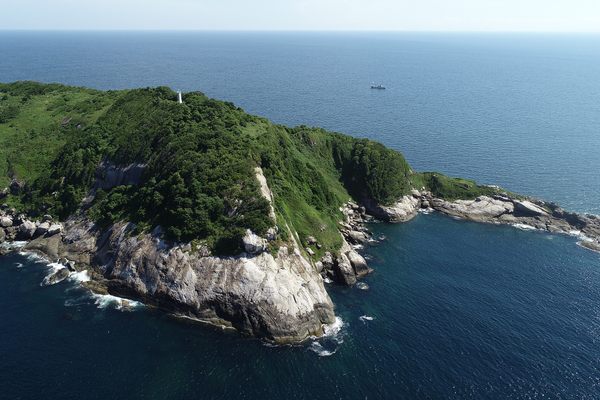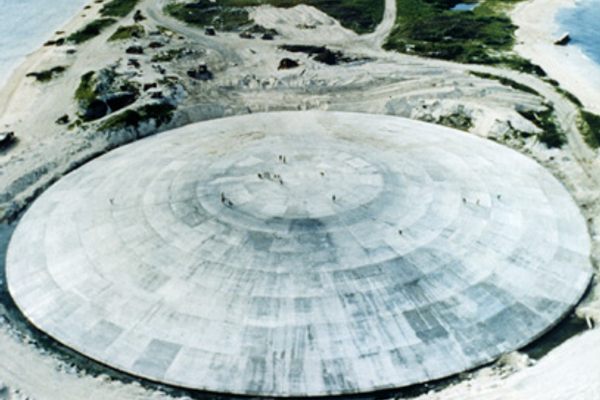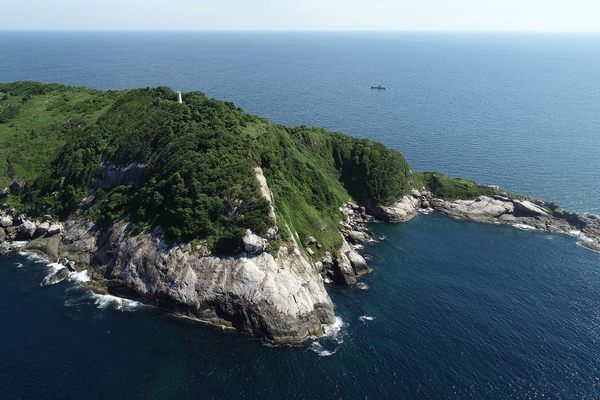Atlas Obscura’s Guide to Islands You Never Want to Visit

The definitive guide to the worst, most horrible islands in the world including snake ridden deathtraps, radioactive beaches, breeding grounds of disease, poisonous play lands, islands of the insane, and the island kingdom of a murderous madman.
Let’s begin.
A desolate spire covered in the gigantic rare insects. An entomologists dream and everyone else’s nightmare
What’s remote, inaccessible, 1,800 feet tall and populated by a giant, presumed-extinct insects nicknamed “walking sausage”? That would be Ball’s Pyramid.
Scientists had believed the volcanic spire to be completely devoid of life, until a group of researchers paid a visit in 2001 and found a lone shrub clinging to one of the steep cliffs. Resting in its shade were twenty seven, six-inch-long, flightless “Lord Howe stick insects” also known as “land lobsters.”
Last seen in their native habitat the nearby Lord Howe Island a century ago, the massive stick insects were thought to have been eaten to extinction, (Dryococelus Australis) when a ship infested with rats ran aground on the Island.
Further proving the maxim “life will find a way,” their manner of transport from Lord Howe Island to Ball’s Pyramid remains unknown, yet their presence ensures the spire will remain rarely visited, excluding those pilgrimages made by the heartiest of entomologists. (Photo source)
Off-limits and full of venomous pit vipers, its nickname is frighteningly apt
Imagine a place teeming with snakes in such a massive quantity that visitors to the island are never more than three feet from a set of fangs.
Such is the case on Brazil’s Ilha de Queimada Grande, commonly known as “Snake Island.” The estimates set forth by researchers and locals suggest that one to five snakes exist per meter on the island. Not just your average poisonous serpent either, these are golden lancehead pit vipers, a species whose venom painfully corrodes the flesh surrounding the bite wound as the toxins shut down your organs. Grown men have a one-in-ten chance of surviving such a bite… presuming anti-venom is immediately on hand.
Not long ago a fisherman unwitting wandered onto the island to pick bananas, and was bitten. He managed to return to his boat, where he succumbed to the snake’s venom. He is found some time later on the boat deck in a pool of blood. For obvious reasons, the Brazilian government has prohibited everyone from setting foot on the island without express permission given by the Navy. (Photo Source)
.gif)
Miyakejima, Izu Islands, Japan
Island where poisonous gas leaks through the ground and carrying a gas mask is the law
The brave souls inhabiting Miyakejima, one of the Izu Islands, an archipelago just south of Tokyo, have a unique problem. Here, the land rests atop an active volcanic chain. However, the danger isn’t just from volcanic eruptions, but from the highest concentrations of poisonous gasses (primarily sulfur) in the world regularly leaking up through the ground.
In 2000, a mass evacuation was instituted due to extremely high levels of toxic gas in the area Miyakejima residents were permitted to return to their “normal” routines in 2005 though residents are required to carry a gas mask with them at all times.
Hypothetically speaking, were one to visit the Izu Islands, they might wake to a siren in the middle of the night, only to be met in the dark by a confused, wandering child wearing a gas mask, a hand extended asking “Are you my mother?” (Photo Source)
Island famous for manufacturing horrible gases and bunny rabbits
Despite having signed the Geneva Protocol in 1925, a treaty banning the use of poisonous gas, during WWII the Japanese administration converted a remote islands fish processing plant into a secret mustard gas plant, figuring they could get away with it due to its obscured location. They did, producing more then six kilotons of mustard gas.
To keep this poison paradise a secret, the island was literally removed from the map, and workers who lived and worked on this island were sworn to secrecy, all while being regularly poisoned, disfigured and killed by the very gasses they were producing. In addition the government brought thousands of bunnies onto the island to test various poison gases on them, killing them by the thousands.
At the end of the war the plant was set on fire, documents burned and the animals upon which they’d been performing these dark experiments were set free (free!) to roam about the land, unmolested by animal predators and mankind alike.
Today the island is a national park with a museum dedicated to its history and the stories of the workers who labored there. Rabbits now roam the island in massive numbers having reclaimed the island from their tormentors… waiting, waiting for their time to strike back. (Photo Source)
.jpg)
Runnit Island, Marshall Islands
This Islands main feature is an enormous concrete dome built to cover a radioactive nuclear crater
Between 1946 and 1962, the US military conducted 105 atmospheric nuclear tests over the “Pacific Proving Grounds,” a euphemism for the Marshall Islands and several other nearby South Pacific atolls.
In the late 1970s, in an effort to clean up the radioactive debris left by those explosions, the US government dug up 111,000 cubic yards of soil from the Bikini and Rongelap atolls and deposited it on Runit Island. Its resting place would be in a 350-foot wide crater that had been created two decades earlier by an 18-kiloton nuclear test code-named Cactus.
Covering up that giant radioactive pit cost the government nearly a quarter of a billion dollars and took three years to complete. The result: an enormous, foot-and-a-half-thick, 100,000-square-foot dome consisting of 358 gigantic concrete panels. Despite signs warning off visitors, it is still possible to make landfall on Runit and stomp across the Cactus Dome. Bring a Geiger counter. (Photo Source)
Farallon Island Nuclear Waste Dump
Just offshore of San Francisco lay 47,500 drums of nuclear waste and the radioactive wreck of a ten-thousand-ton aircraft carrier
According to the U.S. Geological Survey between 1946 and 1970 ”more than 47,800 drums and other containers of low-level radioactive waste were dumped onto the ocean floor west of San Francisco.” Only thirty miles from the Golden Gate Bridge it is both the first and largest offshore nuclear waste dump in the U.S. When the radioactive waste barrels floated the soldiers shot holes in them to help them sink
Barrels aren’t the only radioactive materials that were dumped at the site. The USS Independence, part of the Bikini Atoll nuclear tests (see Runnit Island) which was stationed half a mile from one of the blasts to test the effects. Once it had been sufficiently annihilated by nuclear blasts, its irradiated smoking wreckage was towed to Farallon to be sunk. Soldiers also reported regularly transporting the carcasses of animals killed in radiation experiments to be dumped at the site.
As of this date there has never been a large scale study of the effects of the areas nuclear contamination. (Photo Source)
Studies have shown that microscopic plastic residue outnumbers the native plankton by a ratio as much as 48-1 and over the years barnacles have begun to grow on the larger pieces of detritus
Photos portraying the innards of dead sea birds who had foraged the area showed soda caps, Barbie legs and buttons in their stomaches. Should sadness oriented vacation be your cup of tea, make your next holiday the Great Pacific Garbage Patch. (Photo Source)
![]()

Biological warfare testing facility left to rot on an island that is no longer an island
In 1948 a top secret facility was established on Vozrozhdeniye Island to test bioweapons. Experiments with anthrax, plague and smallpox were conducted here in open air tests in the 1950s. By being on an island it would keep the facitly secret as well as keep the pathogens from escaping.
In the sixty some years since it was created the Aral Sea that surrounded the island has slowly turned into a desert after being drained by aggressive Soviet irrigation projects. In the 1990s the base itself was hastily abandoned following the breakup of the Soviet Union, and the canisters of disease agents buried. In the years since the abandonment, the island itself has slowly become part of the mainland once again.
A US anti-terrorist team visited the remains of the island in 2001, in theory to clean up any remaining bio-warfare agents, but a visit by author Nick Middleton in 2005 showed signs that there was still plenty to be worried about. He found the island crawling with local looters, disturbing old buildings, and wearing no protection. Test tubes and feeding troughs for test animals were still in place. Although some diseases like smallpox can be virtually eliminated by exposure to UV over time, the same can not be said for Anthrax which has a very long and stubborn lifespan, and once inhaled, has a mortality rate of 90%. (Photo Source)

Russia isn’t the only one with an “Anthrax Island”
Before the Russians had even laid the first brick for the Vozrozhdeniye Island bioweapons facility, the British were busy developing Anthrax as a weapon of WWII.
Begun in 1942, a highly virulent strain of Anthrax known as ”Vollum 14578” was tested by filling “bombs” with the deadly bacteria. Once detonated the bombs would burst and cloud of brown deadly dust would drift down onto a flock of unsuspecting sheep. Though the army learned that they could indeed contaminate German cities so thoroughly as to make them uninhabitable for decades, in the process they made Gruinard itself uninhabitable for nearly five decades.
In the early 1980s the island, which had been left contaminated with Anthrax, became a public threat when a group calling themselves ”Operation Dark Harvest” began sending soil from the island to government facilities and demanding the island be cleaned. The soil was sufficiently contaminated that these were seen as genuine threats.
In 1986 the government began cleaning up Gruinard Island by spraying down the entire place with a formaldehyde solution. As of 1990 the island was declared “safe” and in 1997 the history of project was declassified for the first time. Not everyone is convinced. In the words of one skeptic “It is a very resilient and deadly bacterium.” (Photo Source)
.jpg)
An “island of the insane” home to the black death, a hellish insane asylum, and a mad doctor.
By the 1700s, Poveglia island had already laid abandoned for hundreds of years, but the islands ‘s military fortress “The Octagon” was brought back into service when the Black Death reached Venice’s shores.
In 1793 Poveglia was established as a “temporary” quarantine base for plague infected Venetians. When infected citizens were identified, they were relocated - by force- to Poveglia; and anyone who was thought to be showing symptoms was dragged to the isolated isle, including the uninfected, who were effectively sent to their deaths. Logically, stories of hauntings ensued.
Fast-forward to 1922 when the old quarantine grounds were refashioned to house a hospital for mentally insane. History repeats itself, and those times were not kind to the mentally ill. Many of the inhabitants of the hospital found themselves there for no good reason besides bei and earned an experimental surgery in the bargain.
Circumstances in the hospital were terrible and to top it off, patients reported visitations from the ghosts of decomposing plague victims. It is said that a “mad doctor” roamed the halls until he threw himself from the bell tower. (Or was strangled by a strange mist that rose from Poveglia’s ground… it’s not a very reliable story.) Today the small island remains off limits to all visitors, though its bell tower still looms large on the horizon. (Photo Source)
“The Island of the Dolls” An island covered in eyeless decaying dolls… sleep tight!
Thanks to pop culture gems such as Child’s Play, many of us become uneasy around dolls well into so-called “adulthood.”
Make those baby dolls, filthy, mutilated, exposed to the elements and all hanging from trees on a Mexican island for the past six decades or so and you have the stuff on nightmares. Such is the situation at the Isla de las Muñecas in one of Mexico City’s boroughs.
Once upon a time, in the 1950’s, a loner named Don Julio Santana Barerra made his home on an island (or chinampa) in the midst of Xochimilco’s canals. Stuffing the unserviced structure he called home full of the dolls, Santana Barerra considered them living beings “forgotten” by time.
In his mind, they returned his service of acknowledging their presence by bestowing blessings on his harvests. He’d take them on tours of the property, moving them from limb to limb so they didn’t become bored. For decades, the island went untouched. No one outside immediate family paid him visit, which amounted to the Isla de las Muñecas remaining undiscovered until the early 1990’s as Xochimilco was transforming into a pleasure boat thoroughfare for tourists.
Barerra continued to call the Isla de las Muñecas his home until his death by drowning in 1992, though his decorations remain accessible to visitors willing to bribe their gondola operators to pass near enough for a visit. (Photo Source)
Just you, the beach, and a murderous rapist mad “king”
Clipperton Island is so remote that even the Guinness Book of World Records’ “Most Traveled Man” was given no recourse but to swim there. Factually speaking, the atoll in the East Pacific is equally as inhospitable as it is hard to reach: the land is barren with no freshwater to be found, and treacherous reefs surround it on all sides. Given all that, it’s still palm-laden, lagoon rimmed paradise of crystalline waters known for hosting a massive population of crabs and sea fowl.
So why does it appear on this list? In 1906, a guano mining business jointly operated by British and Mexican interest groups made the only good-faith attempt at colonizing the island in its long history. One hundred men and women were deposited on the island, knowing full-well that they would depend on shipments of sustenance sent from mainland Mexico for their survival. Everything went as planned until the Mexican Civil War diverted the suppliers’ attention… for years.
Slowly but surely, all the men died from either malnutrition or failed escape attempts, save one: Victoriano Álvarez. As the last living male, he proclaimed himself “king” and took to enslaving, murdering and raping the remaining women and children. Ultimately the women conspired and successfully gave him a dose of his own medicine before the final handful of survivors (pictured above) were rescued by a passing ship.
No attempts at permanently colonizing Clipperton have been made since.
See a map of all the islands mentioned above here!



.jpg)
.jpg)

.jpg)











Follow us on Twitter to get the latest on the world's hidden wonders.
Like us on Facebook to get the latest on the world's hidden wonders.
Follow us on Twitter Like us on Facebook